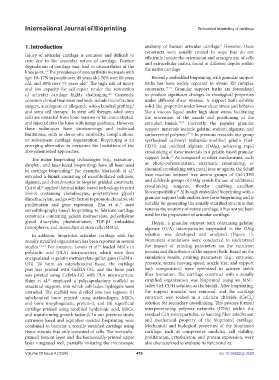Page 484 - IJB-10-4
P. 484
International Journal of Bioprinting Embedded bioprinting of cartilage
1. Introduction anatomy of human articular cartilage. However, these
6
constructs were usually created in ways that do not
Injury of articular cartilage is common and difficult to efficiently imitate the orientation and arrangement of cells
cure due to the avascular nature of cartilage. Further and extracellular matrix found at different depths within
degradation of cartilage may lead to osteoarthritis of the the native cartilage.
1,2
knee joint. The prevalence of osteoarthritis increases with
age: 10–17% in people over 40 years old, 50% over 60 years Recently, embedded bioprinting with granular support
old, and 80% over 75 years old. The high risk of injury baths has been widely reported to obtain 3D complex
3
and low capacity for self-repair render the restoration constructs. 17–22 Granular support baths are formulated
of articular cartilage highly challenging. Currently, to produce significant changes in rheological properties
4,5
common clinical treatment methods include microfracture under different shear stresses. A support bath exhibits
6
surgery, autologous or allogeneic osteochondral grafting, solid-like properties under lower shear stress and behaves
and stem cell therapy. In stem cell therapy, adult stem like a viscous liquid under high shear stress, facilitating
7
cells are extracted from bone marrow or fat, concentrated, the movement of the nozzle and positioning of the
and injected into the knee with image guidance. However, extruded bioink. 23,24 Currently, the popular granular
these techniques have shortcomings and technical support materials include gelatin, sodium alginate, and
limitations, such as donor-site morbidity, complications, carboxyvinyl polymer. 23–26 In previous research, our group
or subsequent cartilage degeneration. Bioprinting is an synthesized carbonyl hydrazide-modified gelatin (Gel-
emerging alternative to overcome the limitations of the CDH) and oxidized alginate (OAlg), achieving rapid
abovementioned approaches. crosslinking of these materials in a gelatin-based granular
27
The major bioprinting technologies (e.g., extrusion-, support bath. As compared to other mechanisms, such
droplet-, and laser-based bioprinting) have all been used as photo-polymerization, enzymatic crosslinking, or
in cartilage bioprinting. For example, Markstedt et al. chemical crosslinking with metal ions or agents, the Schiff
8
9
extruded a bioink consisting of nanofibrillated cellulose, base reaction between free amino groups of Gel-CDH
alginate, and chondrocytes to bioprint gridded constructs. and aldehyde groups of OAlg avoids the use of additional
Cui et al. applied thermal inkjet-based technology to print crosslinking reagents, thereby enabling excellent
10
28
bioink containing chondrocytes, poly(ethylene glycol) biocompatibility. Although embedded bioprinting with a
dimethacrylate, and growth factors to promote chondrocyte granular support bath enables free-form bioprinting and is
proliferation and gene expression. Zhu et al. used suitable for generating the zonally stratified structure that
11
stereolithography-based bioprinting to fabricate cartilage restores the anatomy of native cartilage, it has not yet been
constructs containing gelatin methacrylate, polyethylene used for the preparation of articular cartilage.
glycol diacrylate, photoinitiators, TGF-β1 embedded Herein, a granular support bath containing gelatin/
nanospheres, and mesenchymal stem cells (MSCs). alginate (G/A) microparticles suspended in the OAlg
In addition, bioprinted articular cartilage with the solution was developed and analyzed (Figure 1).
zonally stratified organization has been reported in several Numerical simulations were conducted to understand
studies. 12–14 For instance, Levato et al. loaded MSCs in the impact of printing parameters on the extrusion
15
polylactic acid (PLA) microcarriers, which were then process and disturbance of the support bath. Based on the
encapsulated in gelatin methacrylate-gellan gum (GelMA- simulation results, printing parameters (e.g., extrusion
GG). To form an osteochondral tissue, the cartilage pressure, nozzle moving speed, nozzle size, and support
part was printed with GelMA-GG, and the bone part bath composition) were optimized to achieve stable
was printed using GelMA-GG with PLA microcarriers. fiber formation. The cartilage construct with a zonally
Shim et al. employed a polycaprolactone scaffold as stratified organization was bioprinted using an MSC-
16
structural support, into which cell-laden hydrogels were laden Gel-CDH solution as the bioink. After bioprinting,
extruded. The scaffold was divided into two regions: (i) the support material was removed, and the cartilage
subchondral bone printed using atelocollagen, MSCs, construct was soaked in a calcium chloride (CaCl )
2
and bone morphogenetic protein-2, and (ii) superficial solution for secondary crosslinking. This process formed
cartilage printed using modified hyaluronic acid, MSCs, interpenetrating polymer networks (IPNs) within the
and transforming growth factor-β. In our previous study, residual G/A microparticles, enhancing fiber attachment
extrusion-based and aspiration-assisted bioprinting were and mechanical property of the bioprinted cartilage.
combined to bioprint a zonally stratified cartilage using Mechanical and biological properties of the bioprinted
tissue strands that only consisted of cells. The vertically- cartilage, such as compressive modulus, cell viability,
printed bottom layer and the horizontally-printed upper proliferation, cytoskeleton, and protein expression, were
layer integrated well, partially imitating the microscopic also characterized to evaluate its functionality.
Volume 10 Issue 4 (2024) 476 doi: 10.36922/ijb.3520

